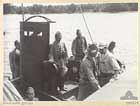 Human face of war Relations with locals on Buka Island |
After the war, KAWANISHI wrote an account of his experience in Bougainville, in which he described relations between the Japanese occupiers and the local people on Buka Island. Relations between the two, according to KAWANISHI, were initially amicable, with goods traded for local products. Once the supply situation on the island worsened, however, incidents of theft of crops and animals by Japanese troops increased. There were also cases of abduction, rape and murder of local women.
While naval headquarters in Buin were concerned with the situation, and issued instructions concerning relations with the locals, it was up to KAWANISHI and another staff officer, Lieutenant GOTÔ Daisaku, to implement comprehensive local policies to improve the situation. KAWANISHI and GOTÔ’s efforts resulted in significant improvements in relations which ultimately benefited both groups.
Three basic principles underlay KAWANISHI’s efforts: to reduce contact between ordinary Japanese troops and the locals; to restore the authority of the village chiefs and appoint Pacification Officers to liaise with them; and to introduce capital punishment for Japanese troops who stole from the locals. Around twenty non-commissioned officers were subsequently appointed as Pacification Officers. They were dressed in formal navy uniform and resided in the villages in close contact with the locals. Village chiefs were also provided with surplus navy caps and uniforms and assisted by the Pacification Officers in restoring traditional networks of authority.
The main feature of KAWANISHI’s efforts, however, was the establishment of a school for young local men at Tulatu in the mountains of south Buka Island. Groups of men from various village districts would attend the school on a rotational basis. They were taught Japanese agricultural methods, how to produce tools such as shovels and picks from old automobile springs and drum cans, how to collect fish with home-made explosives, and how to collect salt and use this to cure the surplus catch. Half the food produced from the training conducted at the school went to the locals, and the other half to the navy.
After the young men returned to their villages, their new-found knowledge was used to produce a surplus, which was controlled by the local village chiefs. This system provided stability for the local people as well as a potential logistics system for the Japanese forces during battle. Thefts from the locals by Japanese troops ceased, according to KAWANISHI’s account, as did other incidents of trouble. The Pacification Officers also developed strong ties to the villages as they carried out their liaison duties.
KAWANISHI recalls in his account how five or six elderly chiefs went to the Bonis Peninsula to bid him farewell just prior to the arrival of the Australian troops at the end of the war. He was deeply moved by the gratitude expressed by the chiefs, and their appreciation for being treated as friends. His last image of them was slinking off into the jungle, with their Japanese navy caps hidden behind their backs, as the victorious Australians approached.
Contributed by Steven Bullard (AJRP)
Sources
FUJIMOTO Takehiro, Bûgenbiru senki (Record of war in Bougainville), Tokyo: Kôjinsha, 2003.
Note
KAWANISHI Shôtaro changed his name after the war to FUJIMOTO Takehiro.
Related links
 Overview
Overview Campaign text
Campaign text  Local relations
Local relations  Bougainville units (Jpn)
Bougainville units (Jpn)  Bougainville units (Aust)
Bougainville units (Aust)
Human face of war
| ||||
| ||||
| ||||
| ||||
| ||||
| ||||
Click images to enlarge.

AWM 096576

AWM 096629

Bougainville
The AJRP has wound up its activities at the Memorial for the moment. Please contact the relevant officer of the Australian War Memorial for assistance. Internet implementation by Fulton Technology and AJRP staff . Visit the Australian War Memorial home page. |